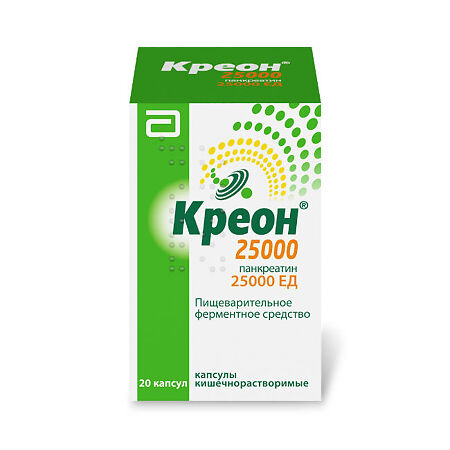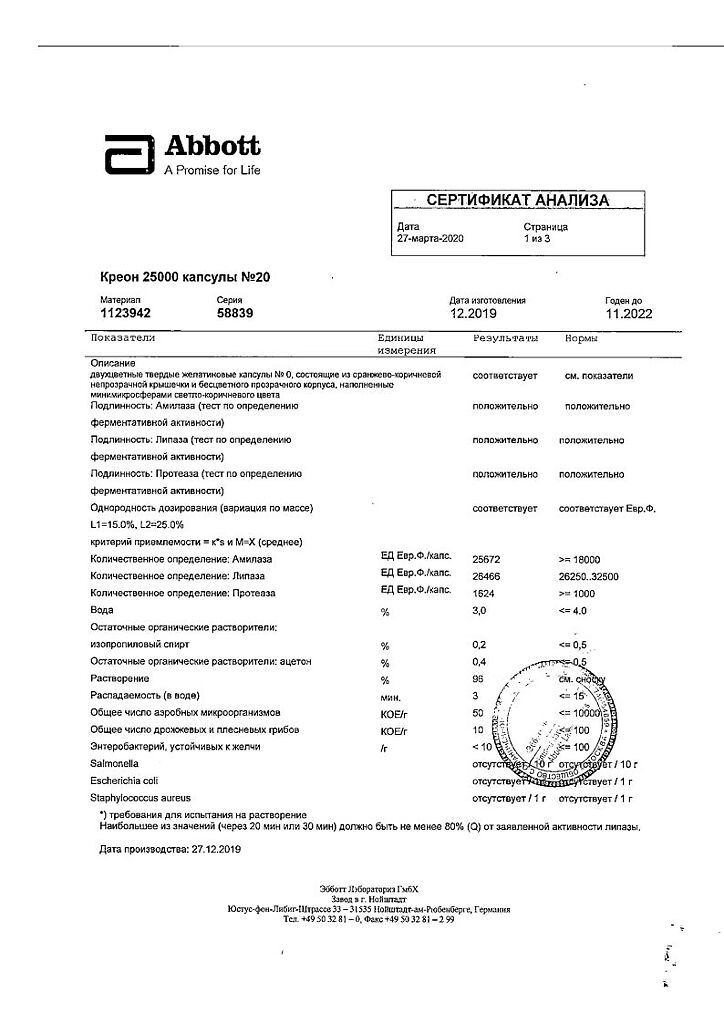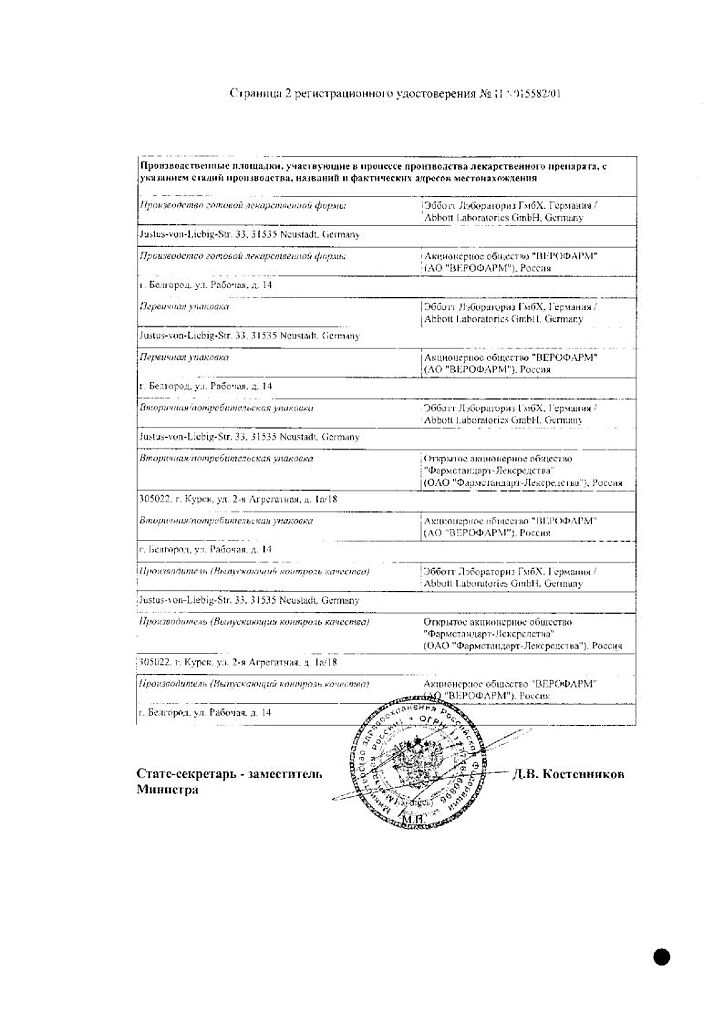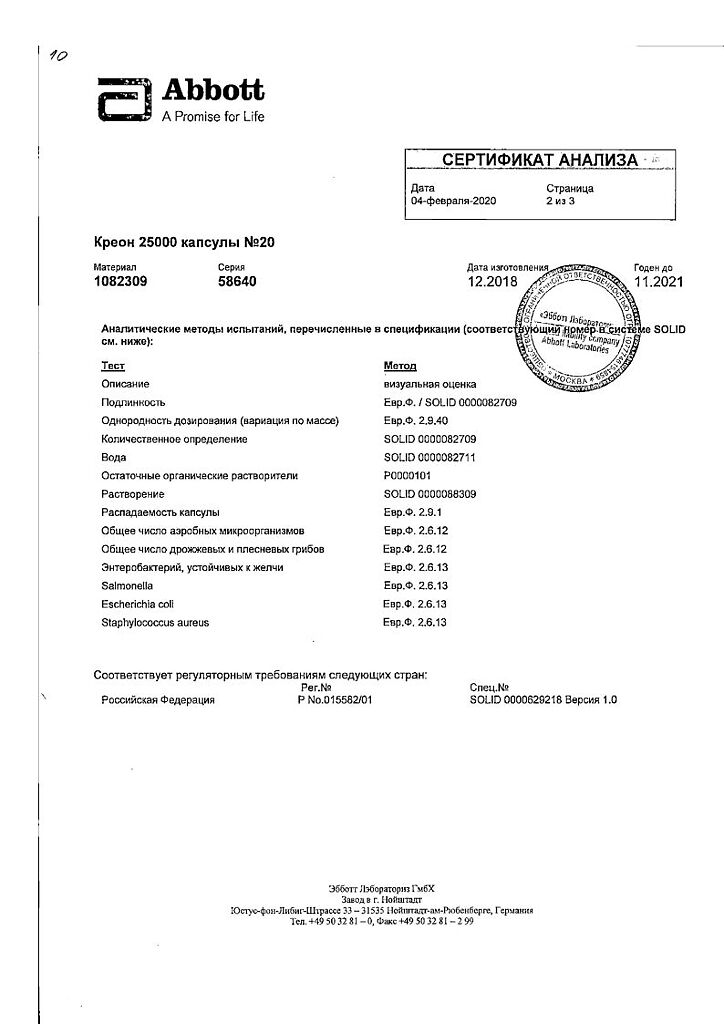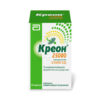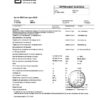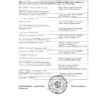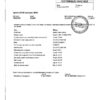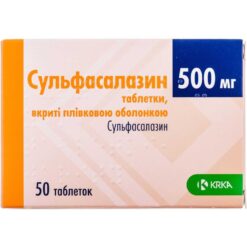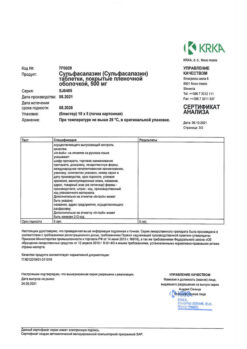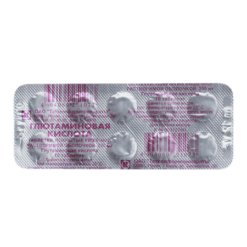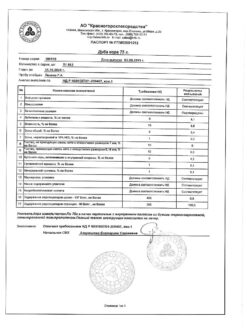No products in the cart.
Creon 25000,25000 units 20 pcs
€17.07 €14.80
Out of stock
(E-mail when Stock is available)
Description
An enzyme preparation that improves the digestive processes. Pancreatic enzymes contained in the drug facilitate the digestion of proteins, fats, carbohydrates, which leads to their complete absorption.
The drug has a specially designed dosage form – a gelatin capsule containing enteric minimicrospheres. The capsules dissolve quickly in the stomach, releasing hundreds of minicrospheres.
The purpose of the multiple-dose principle here is to mix the minicrospheres with the intestinal contents and ultimately to better distribute the enzymes within the intestinal contents once they are released.
When the minicrospheres reach the small intestine, their enteric coating breaks down, causing the release of pancreatic enzymes with lipolytic, amylolytic and proteolytic activity, resulting in the disintegration of fat, starch and lipid molecules.
Indications
Indications
Replacement therapy for exocrine pancreatic insufficiency in the following conditions: cystic fibrosis, chronic pancreatitis, pancreatectomy, pancreatic cancer, ductal obstruction due to neoplasm (for example, obstruction of the pancreatic ducts or common bile duct), Shwachman-Diamond syndrome, old age.
For symptomatic treatment of digestive disorders in the following cases: conditions after cholecystectomy, partial gastrectomy (Billroth-1/P), total gastrectomy, duodeno- and gastrostasis, biliary obstruction, cholestatic hepatitis, cirrhosis of the liver, pathology of the terminal part of the small intestine, excessive bacterial growth in the small intestine.
To avoid complications, use only after consulting a doctor.
Pharmacological effect
Pharmacological effect
An enzyme preparation that improves digestion processes. Pancreatic enzymes included in the drug facilitate the digestion of proteins, fats, and carbohydrates, which leads to their complete absorption.
The drug has a specially developed dosage form – a gelatin capsule containing enteric mini-microspheres. The capsules quickly dissolve in the stomach, releasing hundreds of minimicrospheres.
The purpose of the multi-unit dose principle, which is implemented in this case, is to mix the mini-microspheres with the intestinal contents and ultimately better distribute the enzymes within the intestinal contents after their release.
When the minimicrospheres reach the small intestine, their enteric coating is destroyed, which entails the release of pancreatic enzymes with lipolytic, amylolytic and proteolytic activity, leading to the disintegration of fat, starch and lipid molecules.
Special instructions
Special instructions
The drug should not be used orally in the early stages of acute pancreatitis. Children with cystic fibrosis who take Creon® 25,000 for a long time should be under regular supervision by a specialist.
Strictures of the ileum and cecum and colitis have been described in patients with cystic fibrosis treated with high doses of pancreatin preparations. In case-control studies, there was no evidence of a relationship between the occurrence of fibrosing colonopathy and the use of Creon®.
As a precaution to exclude colonic involvement, any unusual symptoms or changes in the abdominal cavity should be monitored, especially if the patient is taking (lipase based) more than 10,000 Ph units. Eur./kg body weight/day.
Taking Creon® is allowed for patients who profess Islam and Judaism. Effect on the ability to drive vehicles and operate machinery The drug does not affect the ability to drive a vehicle or operate machines and mechanisms.
Active ingredient
Active ingredient
Pancreatin
Composition
Composition
One capsule contains:
Active substance:
pancreatin 300 mg,
Excipients:
macrogol 4000 – 75 mg,
hypromellose phthalate – 112.68 mg,
dimethicone 1000 – 2.69 mg,
cetyl alcohol – 2.37 mg,
triethyl citrate – 6.26 mg.
Composition of the hard gelatin capsule shell:
gelatin – 95.08 mg,
red iron oxide dye (E172) – 0.46 mg,
iron dye yellow oxide (E172) – 0.08 mg,
titanium dioxide (E171) – 0.19 mg,
sodium lauryl sulfate – 0.19 mg.
Pregnancy
Pregnancy
The use of Creon® during pregnancy and lactation (breastfeeding) is possible only if the expected positive effect of therapy for the mother outweighs the possible risk to the fetus or child, due to the lack of reliable clinical data confirming the safety of the use of pancreatic enzymes in this category of patients.
Contraindications
Contraindications
acute pancreatitis;
exacerbation of chronic pancreatitis;
hypersensitivity to porcine pancreatin and other components of the drug.
Side Effects
Side Effects
When evaluating data from clinical studies, the overall incidence of adverse reactions associated with pancreatin use was similar to that observed with placebo.
From the digestive system: often – abdominal pain; in some cases – constipation, stool changes, diarrhea, nausea, vomiting.
Allergic reactions: in some cases – skin manifestations, hypersensitivity reactions.
Interaction
Interaction
No studies have been conducted
Overdose
Overdose
Symptoms: hyperuricosuria and hyperuricemia.
Treatment: drug withdrawal, symptomatic therapy.
Storage conditions
Storage conditions
At a temperature not exceeding 25 °C, in tightly closed packaging
Shelf life
Shelf life
1 year
Manufacturer
Manufacturer
Abbott Laboratories GmbH, Germany
Additional information
| Shelf life | 1 year |
|---|---|
| Conditions of storage | At a temperature not exceeding 25 °C, in a tightly closed package |
| Manufacturer | Abbott Laboratories GmbH, Germany |
| Medication form | enteric capsules |
| Brand | Abbott Laboratories GmbH |
Related products
Buy Creon 25000,25000 units 20 pcs with delivery to USA, UK, Europe and over 120 other countries.

